Recently we “got around” to a project more than a decade in the making, namely the rebuilding of the driveway at the homestead. The issue came to a head a while ago when the UPS truck struggled getting up the straight but fairly steep and narrow driveway to the barn. The existing driveway there was a “temporary” path laid down for the initial barn raising eleven years ago, so the time was at hand. Between the hurdles of weather and resources we sorta scheduled the work late last winter and we finally got a stretch of days dry enough for the ground to firm adequately for the heavy equipment. I believe the curb weight for a loaded dump trunk is in the neighborhood of 50,000 pounds.
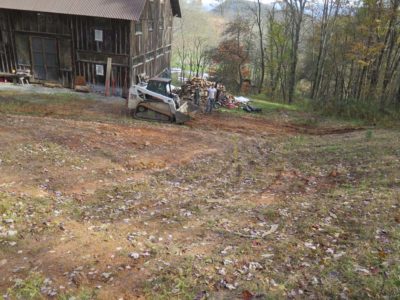

As I understand it the process of building or rebuilding a driveway is dependent on the ability to first lay a deep foundation of cash on the ground. Actually it begins with scraping the bed flat and smooth, then building the roadway with first coarse gravel followed by fine gravel. It packs like concrete.

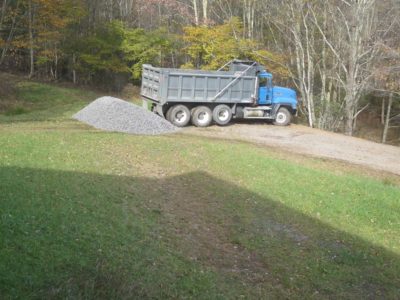
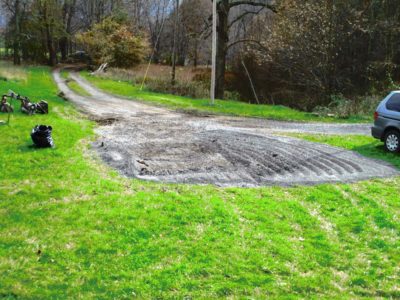
This is then smoothed and packed, and if done well will last for decades. That’s what I’m counting on.
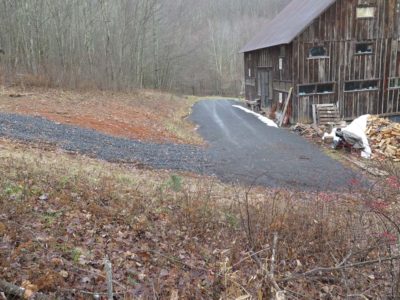
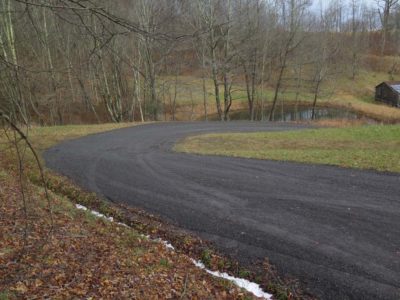

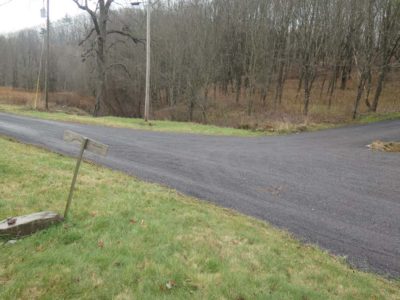
The new driveway crown is a foot higher than previously in some places. Make no mistake about it, this makes coming and going to and from the barn a whole lot easier. Now I will no longer have the UPS/FedEx packages dropped off on the cabin front porch when they are meant for the barn.
On my first trip to visit the HO Studley tool cabinet I was quite expectantly anticipating the absolute headiness of the experience of being in the intimate presence of this iconic artifact. The drive was a test of restraint as it was a long one and I had to reign in my excitement or I would be exhausted by the time I got there. It was all I could do to avoid the temptation of non-stop daydreaming that would splatter me on an underpass, or calling literally every woodworker I knew to ask them, “Guess where I am going?”
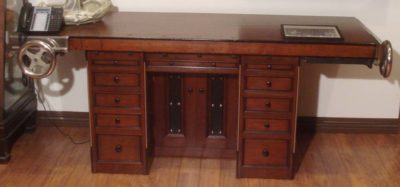
When I arrived and met Mister Stewart, and he ushered me into the room containing the tool cabinet, I literally felt tingles. Indeed, the tool cabinet and its contents were as amazing as I had psyched myself up for, hoping that I would not be disappointed. I wasn’t. But, much to my astonishment I realized that the workbench was every bit the masterpiece that the tool cabinet was. I won’t blow smoke up your shop apron and tell you I spent as much time examining and photographing the bench as I did the tool cabinet, but it was a lot more than I was expecting.
I cannot really see myself using a tool repository like Studley’s for my everyday work, but I definitely could see me using the workbench all day, every day. It was as you might expect from Studley, both ingenious and exquisite and all I kept thinking the day I drove from Studley to Cincinnati for WIA 2010 was, “I gotta make me one of these.” Eventually I worked through Chris Schwarz to acquire a slab of mahogany 4″ thick by 28″ wide by seven feet long to make the top.
I got the slab home and nestled into the barn awaiting the decks to clear so I could begin.
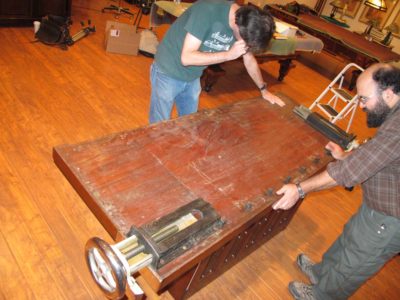

Imagine my surprise when on a later return visit to continue documenting Studley more fully and I was able to study the underside of the bench, and more particularly the holes into which the alignment pins from the under-bench cabinet fit, I discovered that the bench top construction was not what I had expected. Suddenly I had a giant mahogany slab available for another function; Studley’s bench was a laminated construction.


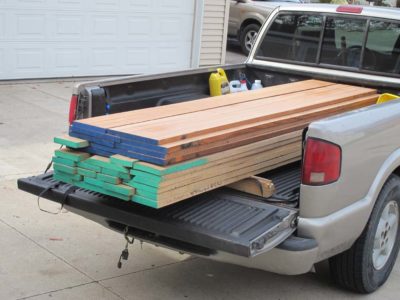
With Jameel Abraham I went to a lumber dealer he patronized and bought what I needed for the bench top. It was select white oak for the core and mahogany for the faces. Notwithstanding the “mahogany” was no such thing, at least I had materials to begin the replica bench to include in the exhibit.
Lest you lose any sleep worrying about the abandoned mahogany slab (it was true swietenia, not the phony pastiche that is often sold as “mahogany”), fear not. I have plans for it in the not-to-distant future.
Stay tuned.
The second day of GroopShop was just as engaging and instructive as the first, and one again I was paying so much attention to the speakers that my photo record was not as good as it should have been.
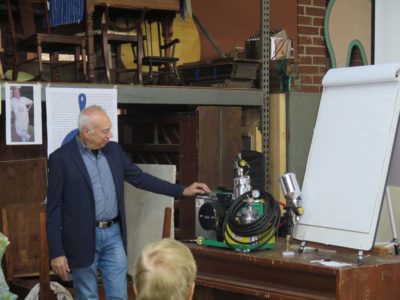
The opening session was a demo by one of the reps from Apollo Spray Systems, the HVLP units used widely in our circles. The blow-by-blow of the history of product development was fascinating to me.

My friends Mark and Valeri from Besway/Benco, manufacturers of chemicals and products for the finishing room, provided a chilling account of the regulatory war against our trade. Do Gooders are relentless, that is why they win unless they are opposed in a smash-mouth fashion by someone with the means to do so. Since sanctimonious moral certitude is the regulator’s fuel, I do not expect us to prevail for the most part.

Freddy Roman gave an impassioned and enlightening talk about using social media for marketing his business. In that realm he really is the Energizer bunny. Were I less curmudgeonly I might go this route.

I gave my 120-minute spiel on “Decoding Hide Glue,” covering everything from manufacture to modification to application. We got almost all of it recorded and it will soon be posted, or at least as soon as I can knit it all together.

Bill Ryan is an on-site-work warrior doing mostly architectural punch-list work in new construction, and he brought his complete traveling workshop with him to show its contents and applications. Very inspiring. I am still kicking myself for not taking a picture of his traveling kit.
Tom Delvecchio presented his recent fascination and exploration of 3D printing and its applications to his work in the restoration shop. I’ve long been considering this technology, and since there is a manufacturer her in this county I will delve more deeply.
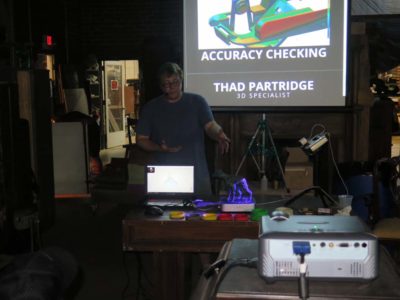
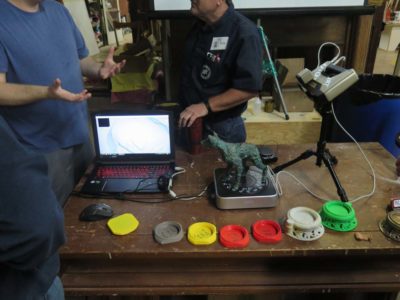
The after-dinner talk was one of the most intriguing I’ve seen as a young fellow demonstrated 3D imaging and its link to robotic 3D manufacturing. The implication for replicating metal furniture parts especially was astounding. We used to work on 3D imaging at SI and the progress made in this area is staggering.
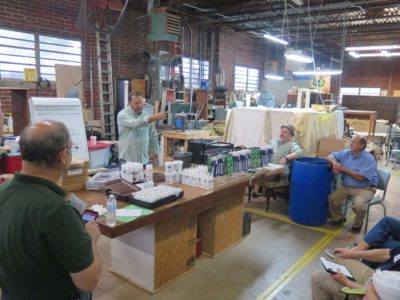
The final presenter for the gathering was the next morning with the rep from Mohawk covering his line of products, and how that offering has changed over time. Like many practitioners of the furniture restoration arts Mohawk is what I cut my teeth on; I attended a Touch-Up workshop back in 1974 and still have drawers full of the materials I got then, using them as needed to this day.
And thus endeth GroopShop 2018. As always I came away inspired and informed. If you have any interest in the finishing and restoration arts, you should belong to the Professional Refinishers Group.



Mrs. Barn and I spent the afternoon at the Atlanta Botanical Garden. It was delightful. Then we drove home. Less delightful.

After many moons of hibernation the Shellac Archive is back among the living! If I can get/keep my act together there will be a new posting every week or so until I have exhausted my 8,000 page archive (the page number is estimated, I have not literally counted every page; it might be more, it might be less). I think I already have about 200 more articles scanned, needing to be formatted and readied for posting.
This offering is the chapter “Natural Spirit Varnish Resins” from the most excellent H.W. Chatfield book Varnish Constituents (1953). As you might expect the chapter places great emphasis on shellac.
Enjoy.
With a number of data points in my hand it was time to give this gelatin mold thing a trial run. For the master pattern I selected one from my inventory of such things, an epoxy replica of a carved element.
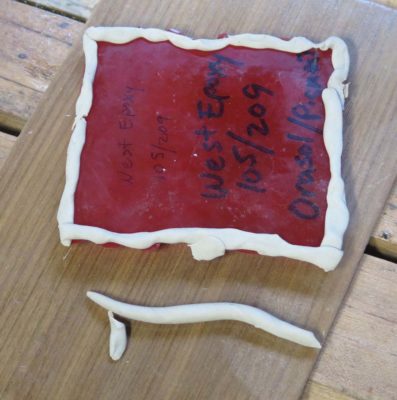
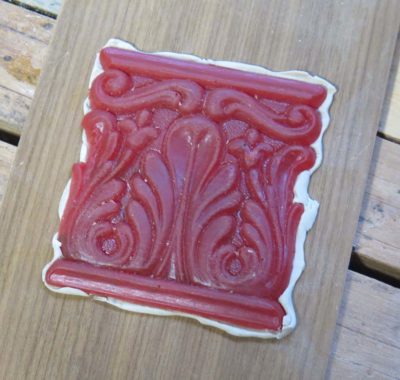

I first affixed the pattern to a flat board using sulfur-free modeling clay as my gasket and adhesive. I have used this method as a rock-solid tried-and-true technique for decades, the sulfur-free aspect is critical whenever the mold-making material is silicon rubber (sulfur inhibits the silicon rubber from setting), and I just use this as my default for every similar application. I cleaned off the excess and brushed the thinnest possible coating of petroleum jelly onto the pattern to assure perfect separation, then dammed the pattern with a rectangle of Lego blocks.
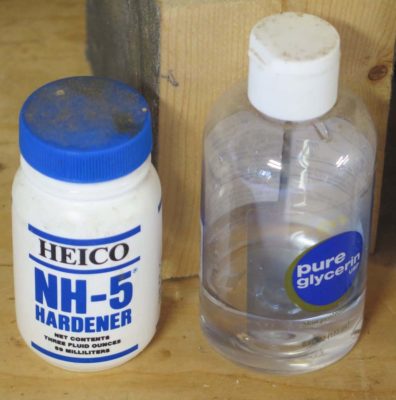
For the gelatin mold material I used 192gws Standard glue, soaked overnight with the water level equal to the height of the glue in the glass jar. I wanted the gelatin to be on the viscous side, remembering that all the water going in has to come out and there are shrinkage issues to consider with that.
Once the glue was cooked and ready, I added 3% of glycerin to it to serve as a plasticizer followed by 2% protein hardener to crosslink the glue (both additions were by weight in proportion to the dry glue granules). I had already learned to allow the glue to cool a bit before adding the hardener as higher temps make the crosslinking go too fast, turning the glue into an heterogeneous lumpy mixture.
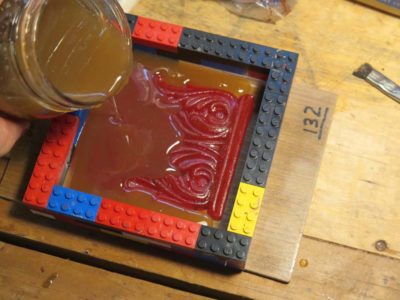
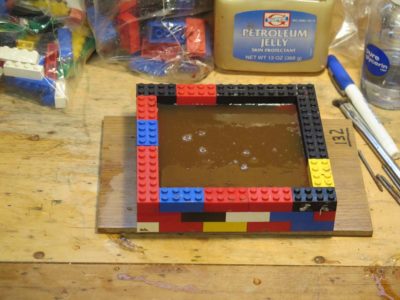
Once everything was ready I simply poured the glue over the pattern until it stood proud of the surface by about 3/8″ and set it aside overnight.

The next day I dismantled the Lego dam and the rubbery block was just what I wanted, it peeled away from the pattern easily. Clearly the hardener was imparting toughness from the git-go and the glycerin enhanced the flexibility of the still-swollen block.
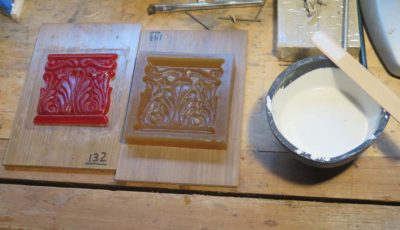


I whipped up a batch of plaster and poured it into the gelatin mold with outstanding results. Well, as outstanding as I could have expected given my impatience, which caused me to de-mold the casting too soon. I should have waited 36 hours instead of 12; the high moisture content remaining in the gelatin mold retarded the setting of the plaster.
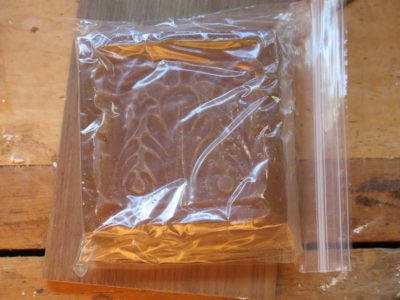
I immediately double bagged the gelatin mold to keep it from drying out, thinking the crosslinker would inhibit mold growth.
Not so much. Two weeks later when I opened it to use it again it was something akin to a slimy special effect for a space alien movie.
Still more territory for improvement on the next try.
By the third year of the Pilgrim settlement, the experiment with communalism having previously resulted in widespread deprivation and death, a theme that continues to this very day for the malignancy known as collectivism, Governor Bradford of Massachusetts perhaps unwittingly acknowledging that property rights always redound in bounteous blessings, made this first Thanksgiving Proclamation, 1623:
Inasmuch as the great Father has given us this year an abundant harvest of Indian corn, wheat, peas, beans, squashes, and garden vegetables, and has made the forests to abound with game and the sea with fish and clams, and inasmuch as He has protected us from the ravages of the savages, has spared us from pestilence and disease, has granted us freedom to worship God according to the dictates of our own conscience.
Now I, your magistrate, do proclaim that all ye Pilgrims, with your wives and ye little ones, do gather at ye meeting house, on ye hill, between the hours of 9 and 12 in the daytime, on Thursday, November 29th, of the year of our Lord one thousand six hundred and twenty three and the third year since ye Pilgrims landed on ye Pilgrim Rock, there to listen to ye pastor and render thanksgiving to ye Almighty God for all His blessings.
William Bradford
Ye Governor of Ye Colony
Amen.
Back at home after GroopShop 2014 Bill continued to assemble, finish, and augment the folding portable workbench we had built as a demo for GroopShop.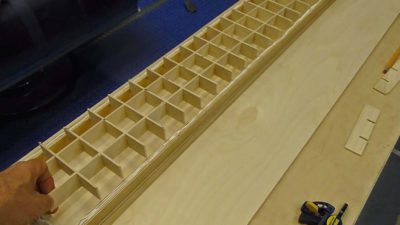
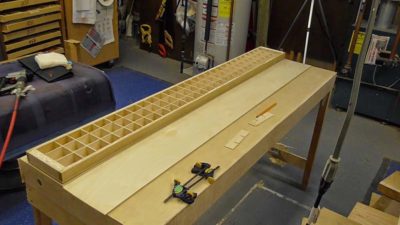
After installing the folding diagonal leg braces he gave it a trial run and found it to be too light for his tastes. Plenty sturdy enough but too light to work with comfortably. So, he made a shelf to fit between the lower cross braces of the legs and serve as a storage space, clearing the space around the bench and adding mass to the overall unit. The shelf was made using the exact same technology as the top. Like the top it was amazingly light in relationship to its strength and utility.
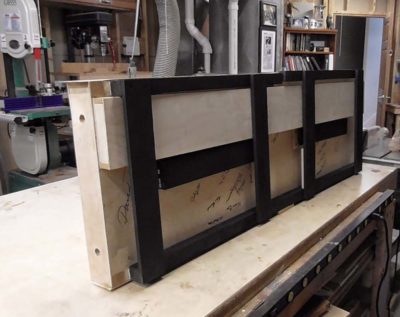
One of the really cool features is that the shelf fits neatly in between the folded legs underneath the top. As you can see he even has room for a second shelf if ever one is needed.

After painting the leg units black, it was going to be used in a museum gallery after all, he set it up and found it to fulfill his needs precisely. I don’t think he ever found the need to install the vises, but the set-up for them remains in place and ready to go any time he needs it.
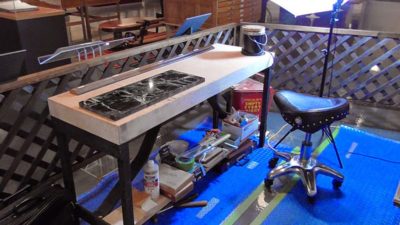
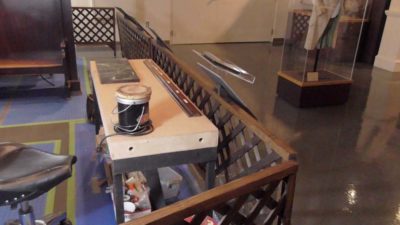

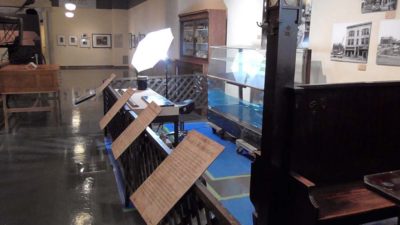
I believe he uses it regularly as a wonderful assembly table in his own shop, ready to be folded up and easily transported to a new on-site project where it is needed.
Sometimes improvement occurs as a flash of inspiration, sometimes through an incremental grind. This bench concept was a bit of both, and the improvements I made in this version carried over into the next folding workbench model, which I believe is workbench #20 or 21 in the series. I will be recounting the changes in great detail.
I do not have a workbench problem. I have a lot of workbenches. Big difference.
I do not normally post about current activities, but I was so excited about my vertigo beginning to subside and my getting back up the hill to the Barn yesterday I just wanted to do so this morning. Under the watchful eye of my visiting brother I spent much of yesterday puttering in the shop, tidying and setting up for some work in The Waxery, that dedicated “clean space” reserved for my mad scientist-y stuff.
Another couple days of improvement like the last two and I will be well on the road to normalcy, or at least what passes for a facsimile of normalcy in my life. I’m still a tad fuzzy around the edges and must be very careful not to turn my head quickly (dizzeryness ensues) or use power equipment, but otherwise it was a most productive day.
I even got all caught up on shipping orders that had accumulated over the previous fortnight.
Just in time for Thanksgiving.
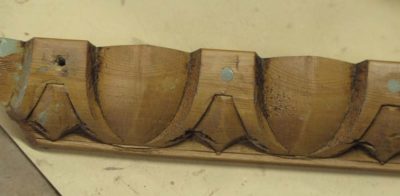
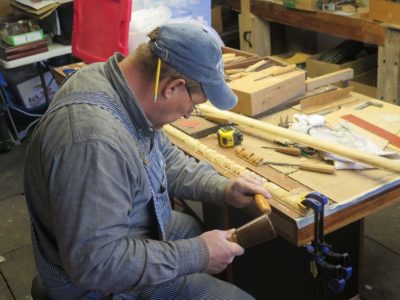
Recently I was called by a nearby acquaintance asking me for a lesson on carving egg-and-dart molding. Sam is a talented restoration carpenter who is a whiz at saving houses old and new, but this project required him to flex a bit and branch out into carving some moldings needed for a fireplace mantle. I said sure and we scheduled a couple of times for him to work in the studio.
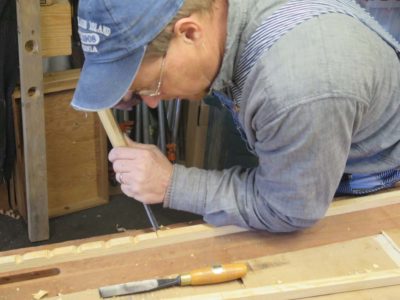
Most egg-and-dart molding involves a very limited number of carving gouges, and the sample he needed to match fit that description. Fortunately for him I had exactly the sweep and size he needed. I sat down and showed him the steps of the procedure then turned the sample piece over to him to, well, practice. I used to carve quite a bit, and there was a period 45 years ago I though about becoming a carver. Not becoming someone who could carve, but someone who was a carver. Big difference. But the lure of the finishing room soon won out, and ever since I’ve only really undertaken carving to replicate missing pieces from my projects.

After a couple of sessions in the Barn, Sam was ready to execute the moldings for real. The initial struggles he had with the fairly coarse-grained workpiece was alleviated the second time around, and the results were gratifying.
With him, I expected no less.
After struggling with my previous attempt to harvest oak from my own mountain, disappointed by the fact that even those large trees, or at least sections of their trunks, yielded so little usable material, I had for the moment hope for two long, straight sections that I had not yet processed. The tree from whence these bolts came had grown tall and straight in a very dense cluster of trees. Those facts led me to my optimism. So recently I headed up the hill with my implements of destruction in-hand.
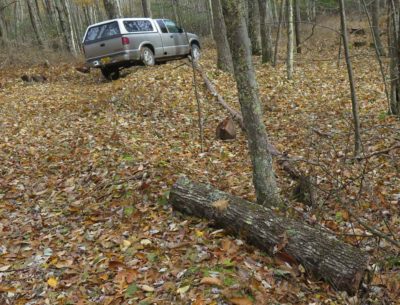

Cutting up the long straight trunk produced the first two segments to be split.
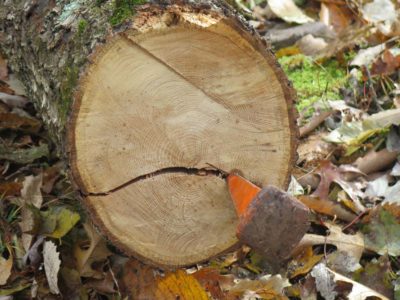
I studied the first of them to decide where to place the first wedge. I drove it in and immediately my heart sank when the split wandered off toward California.

With a deep breath and some impolite utterings under my breath I tried to salvage the situation by putting the second wedge in a place to continue or re-establish the split line I wanted in the first place.
It worked.

Carefully working down that line with more wedges, a nice split was established.
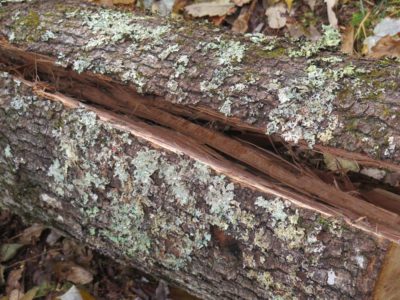
My only concern at this point was the interlocking that emerged but since it was restricted almost completely to only the pith it was no cause for hysteria. A few whacks with the roofer’s hatchet, my “go to” tool for this task, and the problem was resolved as I hoped. It was only a little loss to a region of the trunk I didn’t want in the first place.
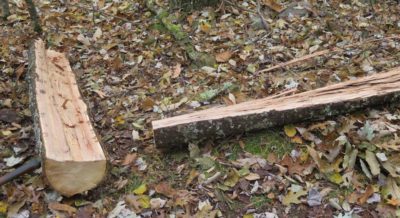

Soon enough I had two halves of a trunk, then four quarters, and in the end, eight wedges.
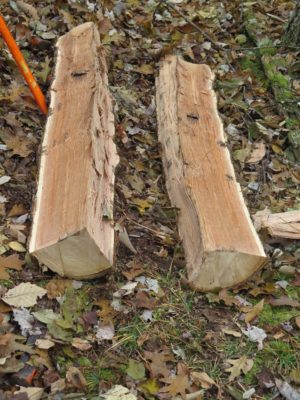
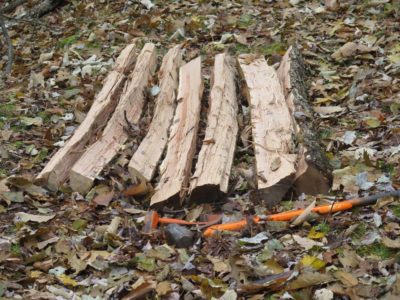
I was pleased with the minimal amount of overall interlocking and wind.
My friends, there be some chairs.






























































Recent Comments